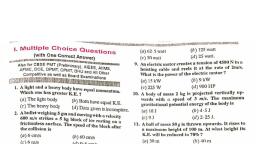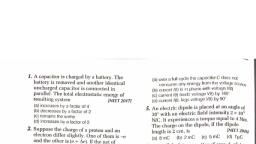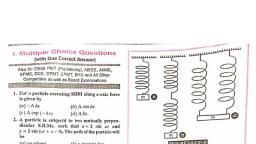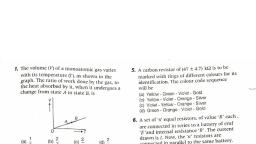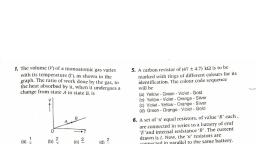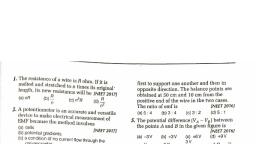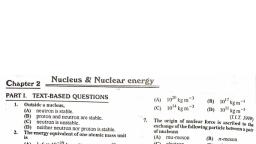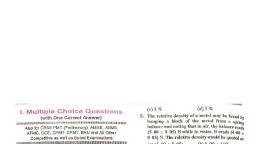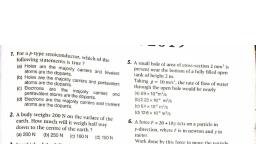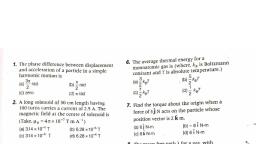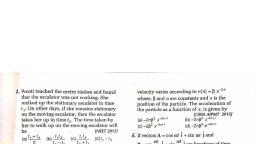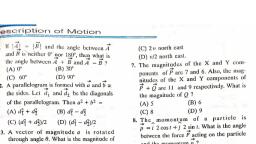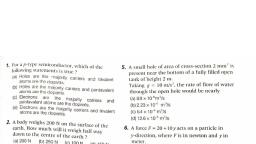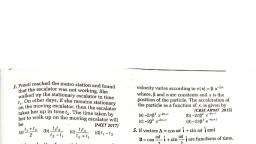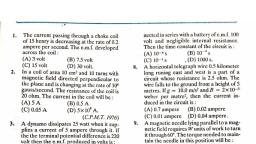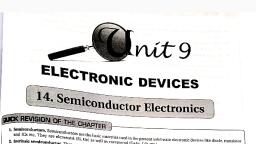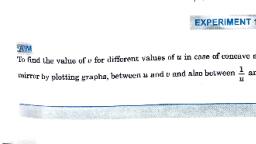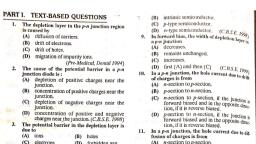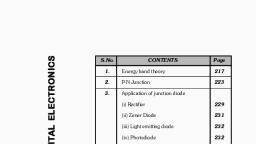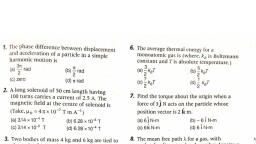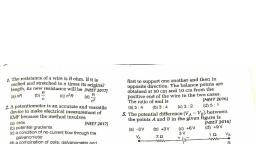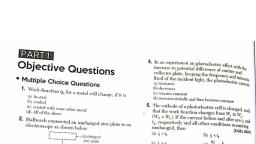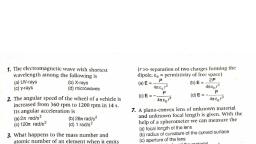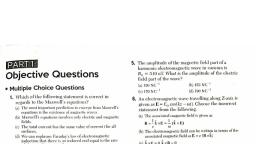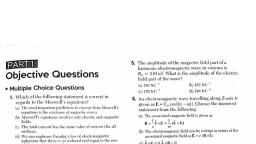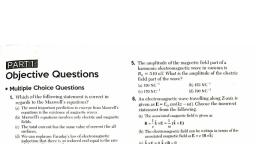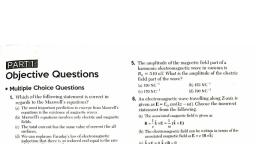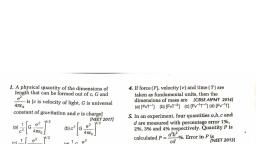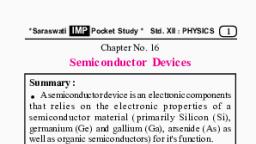Page 1 :
PARTI. TEXT-BASED QUESTIONS, Seance a ne, , The depletion layer in the p-n junction region, , is caused by, , (A) diffusion of carners, , (B) drift of electrons., , (C) drift of holes., , (D) migration of impurity ions., , (Pre-Medical, Dental 1994), , The cause of the potential barrier in a p-n, , junction diode is :, , (A) depletion of positive charges near the, junction., , (B) concentration of positive charges near the, junction., , (C) depiction of negative charges near the, junction., , (D) concentration of positive and negative, charges near_the junction. (C.B.S.E. 1998), , The potential barrier in the depletion layer is, , due to, (A) ions (B) holes, (C) electrons (D) forbidden gap, (BHU, 1999), The barrier potential of a silicon diode at room, temperature is, (A) 0-3V (B) O-7V, (Cc) 1V (D) 2mV, (CET. 1998), Ap-n junction has a thickness of the order of, (A) lcm (B) Imm, (C) 10cm (D) 107 cm, (BLT. 1990), Diffusion of free electrons across the junctions, of an unbiased diode produces, (A) forward bias (B) reverse bias, (C) breakdown (D) depletion layer,, (C.E.T, 1998), , Which of the following statements is not true ?, (A) The resistance of intrinsic semiconductors, decreases with increase of temperature,, (B) Doping pure Si with trivalent impurities, gives p-type semiconductors., (C) The —— carriers in n-type semi-conductors are holes., (D) Ap-n junction can act as a semiconductor, diode. (LLT. 1997), A semiconducting device is connected in a, series circuit with a battery and resistance. A, current js found to pass through the circuit., The polarity of the battery is reversed, then the, current drops to almost zero. The device may, , be a/an, (A) pr junction., , 12,, , 13., , 14,, , 15., , (B) intrinsic seme vd, , (C) p-type semiconductor, , (D) n-type semiconductor (CHLE Gby, , In forward bias, the width of depletion bayer 2, , apr Junction, , (A) decresses, , (B) remains unchanged, , (C) increases., , (D) first (Ayand then(C) (CASE Joy,, , In apn junction, the hole current due to dri, , of charges is from, , (A) n-section to p-section, , (B) p-section to n-section., , (C) n-section to p-section, if the junctian iy, forward biased and in the opposite diree., tion, if it is reverse braised., , (D) p-section to a-scction, if the junction js, forward biased and in the opposite direc., tion, if it is reverse biased., , In a p-n junction, the hole current due to dif., , fusion of charges is from, , (A) n-section to p-section, , (B) p-section to n-section,, , (C) n-section to p-section, if the junction s, forward biased and in the opposite direction, if it is reverse biased., , (D) p-section to n-section, if the juncuon s, forward biased and in the opposite direction, if it is reverse biased., , In a p-n junction, diffusion current is greater, , than the drift current (in magnitude), , (A) if the junction is forward biased,, , (B) if the junction is reverse biased,, , (C) if the junction is unbiased,, , (D) cannot be predicted., , van we apply reverse bias to a junction diode,, , (A) lowers the potential barrier., , (B) raises the potential barrier., , (C) increases the majority carrier current., , (D) decreases the majority carrier curren!, (CEE. 1991), , In case of p-n junction diode at high value of, , reverse bias, the current rises sharply., , value of reverse bias is known as, , (A) cutoffvoliage, (By) zener voltage., , (C) inverse voltage. (1D) _ critical voltage., , (CET. 1), , In a p-n junction diode not connected to", , circuit,, , {A) the potential is same everywhere., , (B) the p-type side is at a higher potential thao, , ~~ -the n-type side.
Page 2 :
rvs BXAMINA HUES #5 _, cis an electric field at the junction, , gure, from the n-type side to the pelype, , sy ther, © durected, el is an electric field at the junction, , cp) the -type side to the rt, directed from the p-type side HT, , , , , , , , , , , , , , , , , , , , , , , , , , , , , , , , , , , , , , , , , , , , , , , , , , , , sue., f forward biasing of p-n junetion,, I - ae of the following figures correctly, Sepicits the direction of flow o carriers ?, P n ° n, 2, (], fa Bea, DG, == sare, a) (B), PB 5 Pp n, < >, -B an +B aia, pS, }, a, 1F i}, (cy, (C.B.S.E, 1995 ,A.F.M.C 1995), , 17. Ap-n-junction diode can be used as :, (A) rectifier. (B) modulator, (C) demodulator (D) amplifier., (C.B.S.E. 1999 ;A.F.M.C. 1997), 18. A full-wave rectifier circuit along with the out, put is shown in the figure. The contribution, from the diode 1 is (are), , , , , , , , 2, =., 1 ouTPuT, [Age Paae, 1 — v iW“, INPUT ourpur, (Ay) Cc (By) A,C, (c) B,D (D) A,B,C,D, (LLT. 1996), , 19. The part ofa transistor which is heavily copes, to produce a large number of fi, ay a irge num! < pees is called, , (C) collector. ., (D) any one out of emitter, base and collector,, (Pre-Medical/Dental, 1993), 20. hie n-p-n transistor is used as an amplifier,, , (A) electrons move from base to collector,, (B) holes move from emitter to base,, , 21., , 22., , 23., , 24., , 25., , 26., , 27., , (C) ant, “ 1+8, , (C) electrons move from collector to bate., , (D) holes move from base to emitter, (CBSE. 1996), , To use 0 transistor as an amplifier (common, , base configuration),, , (A) both junctions are forward biased., , (3) both junctions are reverse biased., , (C) the emitter-base junction is forward, biased and base- collector junction is, reverse biased. ;, , (D) no biasing voltages are required., , (Pre-Medical{Dental ,1994), , {n a common base amplifier, the phase dif, ference hetween the input signal voltage and, the output voltage (across collector and base), , (B) 2/4, (D) =, , (C.B.S.E. 1990), For a transistor, the current amplification factor is 0-8, The transistor is connected in com, mon emitter configuration, The change in, collector current, when the base current chan, is, (A) 0, (C) 2/2, , ges by 6 mA is, (A) 4-8mA (B) 6mA, (C) 8mA (D) 24mA, , (C.E.T. 1991), Inn-p-n transistor circuit, the collector current, is 10 mA. If 90% of the electrons emitted reach, the collector,, (A) the emitter current will be 9 mA., (B) the emitter current will be 11 mA., (C) the base current will be 1 mA., , (D) the base current will be 0-1 mA., , (LLT. 1992), ‘The current relationship between the two current gains @ and f in a transistor is, , ® b=755 @) B=7S, ) a= ith, , CBSE, 199, , The current gain f of a a is 50. m, bape resistance of the transistor, when used in, ns common emitter configuration, is 1 kQ, , © peak value of the collector a.c, current for, An ac, penk input voltage of 0-01 V is, (A) 10044 (B) 250nA, (C) SOOKA (D) 8004A, , (C.B.S.E. 1999), , At :, en is preferable to n triode valve,, , (A) can withstand lar, @ _, as a higher input im}, © can handle eres oa", (D) does not require a heater., (C.P.M.T, 1986; N.CE.R.T, 1978), , ., ‘ger changes in tempera
Page 3 :
28. Tho ratio of the radii of gyration of a, circular dise to that of a circular ring, each, of same mass and radius, around their, respective axes is ICBSE AIPMT 2008}, fayv3°v2 (b)tev2 fepv2:1 (dy v2 V3, , 29. A particle of mass m in the XY-plane with, a velocity v along the straight line AB. If, the angular momentum of the particle with, respect to origin O is L, when it is at A and, , Ly when itis at B, then [CBSE AIPMT 2007], ,, 3, A, oO x, (8) by > Ly, fo) L, =La, , (c} the relationship between L, and L, dapends, upon the slope of tne ine AB, (jl, <Ly, 30, A wheel has angular acceleration of, 3 rad/s* and an initial angular speed of, 2 rad/s. In a time of 2 s, it has rotated, through an angle (in radian) of, {CBSE AIPMT 2007], (a) 6 {6) 10 {c) 12 (a4, , 31. A uniform rod of length J and mass m is, free to rotate in a vertical plane about A., The rod initially in horizontal position is, released. The initial angular acceleration of, the rod is, , 2, (moment of inertia of rod about A is me, , [CBSE AIPMT 2007}, —_—_—, , —————, , 3g by 2! 3g, 5; 59 Org, , 32. A tube of length Z is filled completely with, an incompressible liquid of mass M and, closed at both the ends. The tube is then, rotated in a horizontal plane about one of, its ends with a uniform angular velocity @., , f, (cd) mg =, , The force exerted by the liquid at the otha,, , ond is [CASE Alpaty 200), (a) me {b} haa, (o} Meu? ae, , 33. The moment of inertia of a uniform, circular dise of radius A and mass M about, an axis passing from the edge of the dise, and normal to the disc is [CBSE AIPMT 2006), , 1 pane 2 a 3 pop?, (a) 5 MR (b) MA 5 i (8) 5 a, , 34. Two bodies have their moments of inertia}, and 2 J respectively about their axis of, rolation, If their kinetic energies of rotation, are equal, their angular momenta will be in, , the ratio (CBSE AIPMT 2005}, (a) 1:2 (b) V2.4, (2:1 (0) 1: v2, , 35. Three particles, each of mass m grams, situated at the vertices of an equilateral, AABC of side / cm (as shown in the figure)., The moment of inertia of the system about, a line AX perpendicular to AB and in the, plane of ABC in g-cm? units will be, , {CBSE AIPMT 2004}, x, , Mac, , ay . ey, , (a1($}mv? (b) 2 mi? (o(3}m* co(3)m*, , 36. Consider a system of two particles having, masses m, and m,, If the particle of mass, m, is pushed towards the centre of mass of, particles through a distance d, by what, distance would the particle of mass 1,, move so as to keep the mass centre of, , , , particles at the original PREM ape, Tho (o) Ma, , " m+M mM, , (od Tea
Page 4 :
4 sindent measured the diameter of a small, yf. steel ball using a screw gauge of least count, pool cm. The main scale reading is Simm, and zero of circular scale division coincides, with 25 divisions above the reference level, If, gcrew gauge has a zero crror of —0,004 cm,, the correct diameter of the ball is, (a) 0.053 cm (0) 0.525 em, (o) 0.521. cm (d) 0.529 cm, , wa solid sphere is rotating freely about its, symmetry axis in free space. The radius of, the sphere is increased keeping its mass, same. Which of the following physical, quantities would remain constant for the, sphere?, (a) Rotational kinetic energy, {b} Moment of inenia, {c) Angular velocity, (d) Angular momentum, , The kinetic energies of a planet in an, elliptical orbit about the Sun, at positions, A, Band are Ky, Ky and K,, respectively., AC is the major axis and SB is perpendicular, to AC at the position of the Sun Sas shown, in the figure. Then, (a) Kp < Ky < Ke, , (b) Ky > Kg>Ke, (c) Ky <Kg<Ke, , (d) Kg >K,>Ke, , 40, If the mass of the Sun were ten times smaller, ~ and the universal gravitational constant were, ten times larger in, magnitude, which of, , the following is not, correct?, , (a) Time period of a simple pendulum on the Earth, would decrease, , (b) Walking on the ground would become more, diticult, , [c) Raindrops will fall faster, , () ‘g' on the Earth will not change, , 41., , 43., , 44,, , 8, ¢>°, A c, , A solid sphere is in rolling motion. In rolling, motion, a body possesses translational, kinetic energy (K,) as well as rotational, kinetic energy (K,) simultaneously, The ratio, K,:(K, + K,) for the sphere is, , (a) 10:7 (b) 5:7 (c) 7:10 (d) 2:5, , A small sphere of radius r falls from rest in a, viscous liquid. As a result, heat is produced, due to viscous force. The rate of production, of heat when the sphere attains its terminal, velocity, is proportional to, , (a) 5° (b) * fr (dq) **, , The power radiated by a black body is P and, it radiates maximum energy at wavelength,, Aq. If the temperature of the black body is, , now changed, so that it radiates maximum, , energy at wavelength 2 Xo, the power, , radiated by it becomes nP. The value of mis, 256 4 3 81, (a) — b) = c) = —, (a) B1 (b) > (c) i (d) 356, Two wires are made of the same material and, have the same volume. The first wire has, cross-sectional area A and the second wire, has cross-sectional area 3A. If the length of, the first wire is increased by Al on applying a, force F, how much force is needed to stretch, the second wire by the same amount?, , (a) 4F (b) 6F (c) OF (d) F, , A sample of 0.1 g of water at 100°C and, normal pressure (1,013 x 10° Nm7~) requires, , 54 cal of heat energy to convert to steam at, 100°C. If the volume of the steam produced is, , 167.1 cc, the change in internal energy of the, sample, is, , (a) 42.25, , (6) 208.7 J, (c) 104.3), , (d) 84.5J
